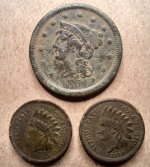silverdollarbill
Hero Member
- Aug 27, 2012
- 898
- 907
- Detector(s) used
- Tesoro Outlaw
- Primary Interest:
- All Treasure Hunting
I picked up these 7 coin silver spoons made my William Moulton for $2. They are not that special, but I think its super cool that you can find 200 year old spoons thousands of miles from where they were made at yard sales.
Something that occurred to me....I've found at least 15-20 of these over the years, but they are all spoons. I've never found a fork. I know they existed, but I can't find one in the wild.
Paging Captain Flintlock.......Why is that? Maybe they were more easily damaged?

Something that occurred to me....I've found at least 15-20 of these over the years, but they are all spoons. I've never found a fork. I know they existed, but I can't find one in the wild.
Paging Captain Flintlock.......Why is that? Maybe they were more easily damaged?





